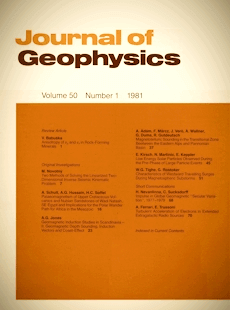Inverse problems = Quest for information
Article Sidebar

Vols. 1-18 (1924-1944), ISSN 0044-2801
Main Article Content
Abstract
We examine the general non-linear inverse problem with a finite number of parameters. In order to permit the incorporation of any a priori information about parameters and any distribution of data (not only of gaussian type) we propose to formulate the problem not using single quantities (such as bounds, means, etc.) but using probability density functions for data and parameters. We also want our formulation to allow for the incorporation of theoretical errors, i.e. non-exact theoretical relationships between data and parameters (due to discretization, or incomplete theoretical knowledge); to do that in a natural way we propose to define general theoretical relationships also as probability density functions. We show then that the inverse problem may be formulated as a problem of combination of information: the experimental information about data, the a priori information about parameters, and the theoretical information. With this approach, the general solution of the non-linear inverse problem is unique and consistent (solving the same problem, with the same data, but with a different system of parameters does not change the solution).
 ARK: https://n2t.net/ark:/88439/y048722
ARK: https://n2t.net/ark:/88439/y048722
Permalink: https://geophysicsjournal.com/article/28
Article Details
References
Backus, G., Gilbert, F. (1968) The resolving power of gross earth data - Geophys. J. R. Astron. Soc. 16, 169-205
Backus, G., Gilbert, F. (1970) Uniqueness in the inversion of inaccurate gross earth data. Philos. Trans. R. Soc. London 266, 123-192
Backus, G. (1971) Inference from inadequate and inaccurate data, Mathematical problems in the Geophysical Sciences: Lecture in applied Mathematics, 14, American Mathematical Society, Providence, Rhode Island
Clearbout, J.F., Muir, F. (1973) Robust modelling with erratic data. Geophysics 38, 5, 826-844
Descombes, R. (1972) Integration. Corollary 6.2, p. 106. Paris: Hermann
Franklin, J.N. (1970) Well posed stochastic extension of ill posed linear problems. J. Math. Anal. Applic. 31, 682-716
Gagnepain, J., Modiano, T., Cisternas, A., Ruegg, J.C., Vadell, M., Hatzfeld, D., Mezcua, J. (1980) Sismicite de Ia region d' Arette (Pyrenees-Atlantiques) et mecanismes au foyer. Ann. Geophys. 36, 499-508
Gallart, J. (1980) Structure crustale des Pyrenees d'apres les etudes de sismologie experimentale. Thesis of 3rd cycle. 132 p. Universite Paris VI
Jackson, D.D. (1972) Interpretation of inaccurate, insufficient and inconsistent data. Geophys. J. R. Astron. Soc. 28, 97-110
Jaynes, E.T. (1968) Prior probabilities. I.E.E.E. Transactions on systems, Science and cybernetics. Vol. SSC-4, No.3, 227-241
Jeffreys, H. (1939) Theory of probability, Oxford: Clarendon Press
Jeffreys, H. (1957) Scientific Inference, London: Cambridge University Press
Keilis-Borok, V.I., Yanovskaya (1967) Inverse problems in seismology, Geophys. J. R. Astron. Soc. 13, 223-234
Parker, R.L. (1975) The theory of ideal bodies for gravity interpretation. Geophys. J. R. Astron. Soc. 42, 315-334
Rietsch, E. (1977) The maximum entropy approach to Inverse Problems. J. Geophys. 42, 489-506
Saba tier, P.C. (1977) On geophysical inverse problems and constraints. J. Geophys. 43, 115-137
Shannon, C. E. (1948) A mathematical theory of communication - Bell System Tech. J. 27, 379-423
Tarantola, A., Valette, B. (1982) Generalized non linear inverse problems solved using the least squares criterion. Rev. Geophys. Space Phys., 19, No.2, (in press)
Wiggins, R.A. (1972) The general inverse problem: implication of surface waves and free oscillations for earth structure. Rev. Geophys. Space Phys. 10, 251-285











